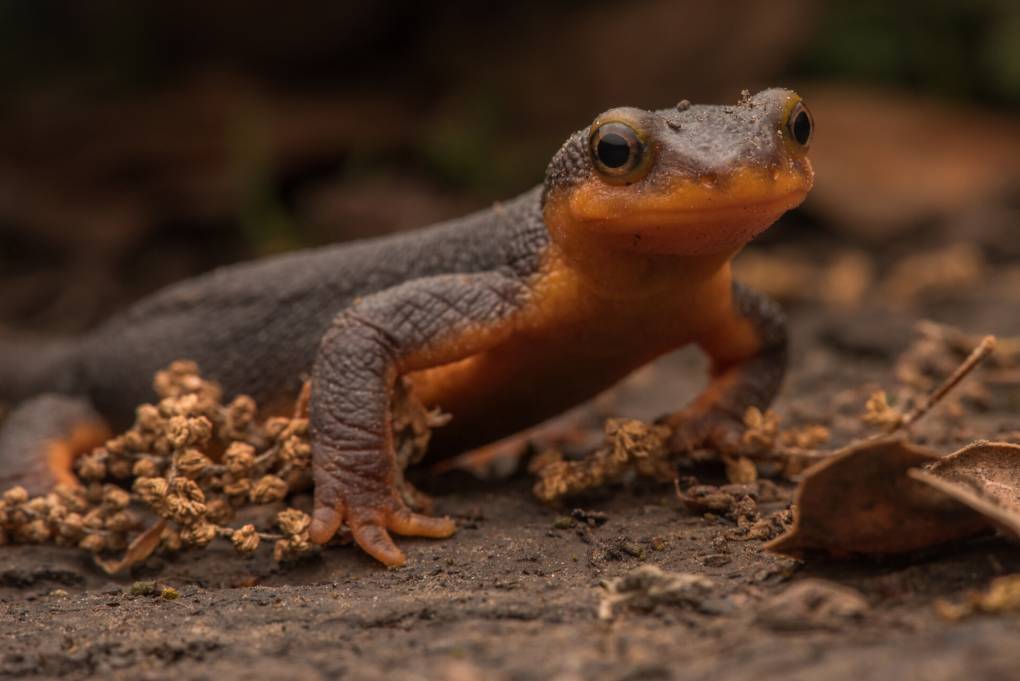Anton Sorokin was hiking in the hills near his home in Berkeley when he came across a pond that was packed full of newts. For a couple of delightful hours, he watched the amphibians swim to the surface for a breath and then plunge underwater again. With a background in herpetology and wildlife photography, Sorokin took some pictures without any particular project in mind. He thought to himself, “Oh, what a great find!”
It was April 2020 and in the ensuing months, Sorokin occasionally drove the 30 minutes from his house to Briones Regional Park, then walked 45 minutes to the pond to see what was happening with the newts. As the season grew warmer, the pond shrank — a typical pattern during the hot, dry summers in this region of California. From his knowledge of the amphibians, Sorokin expected that the water would evaporate eventually and that the newts would strike out for wetter pastures, or else hunker down underground, where some moisture might linger.
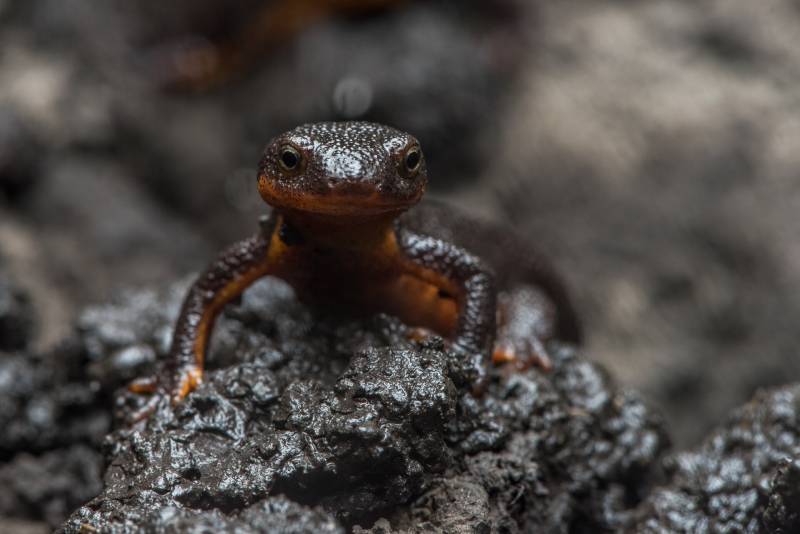
By late July, however, the water in the pond turned from muddy brown to vibrant green. Sorokin noticed hundreds of newts sitting at the edge of the water, their heads poking out, seemingly deprived of oxygen by mats of algae. Normally, they absorb oxygen through their skin while swimming underwater, surfacing only occasionally for air, so this was weird.
Concerned, Sorokin returned frequently, sometimes several times a week. In a summer of wildfires and record-setting heat waves around the area, he watched the pond turn into a field of muddy cracks. Many newts shriveled up and died. When some rain finally came and moistened the mud in November, he watched some survivors hoist themselves out of the cracks and trundle past desiccated carcasses. The next day, all the living newts were nowhere to be seen.
Like many animals, California’s newts are facing new challenges because of climate change, according to growing evidence. Although the animals evolved to deal with drought by delaying reproduction when conditions were extreme, the region has become drier for longer than in the past. These extended droughts and related wildfires are putting an unprecedented level of strain on the amphibians, says Lee Kats, an animal ecologist and conservation biologist who studies newts at Pepperdine University in Los Angeles.
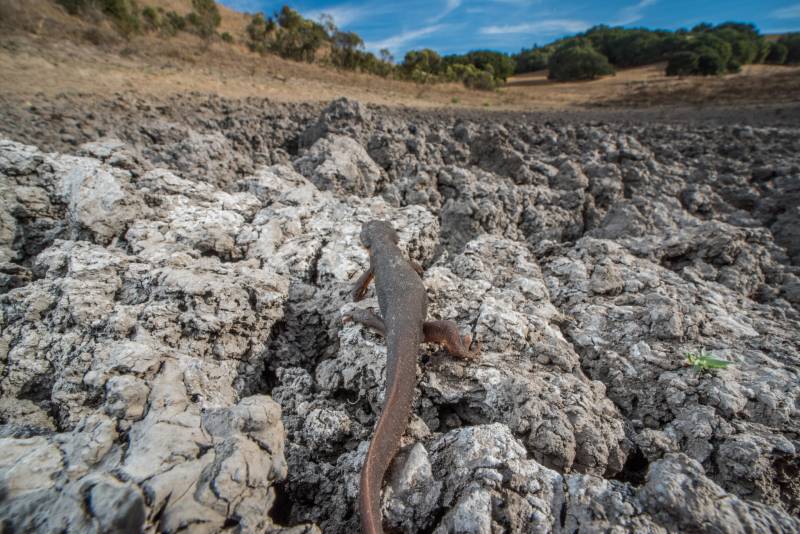
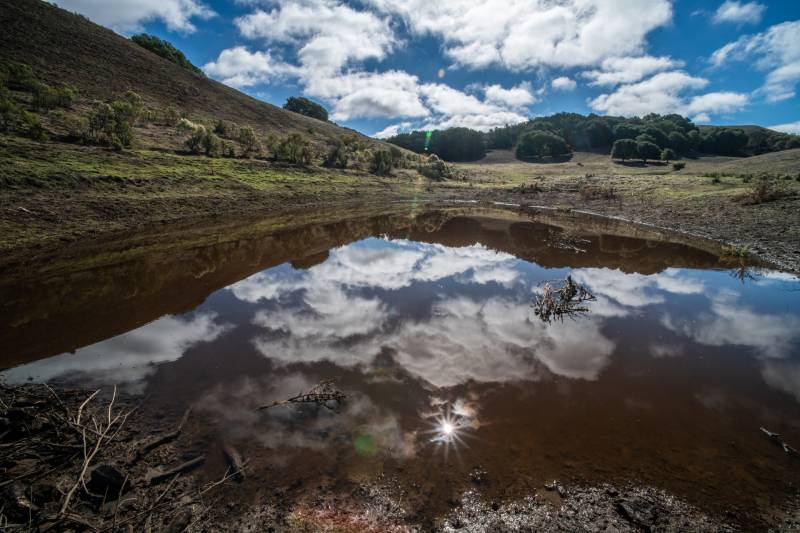
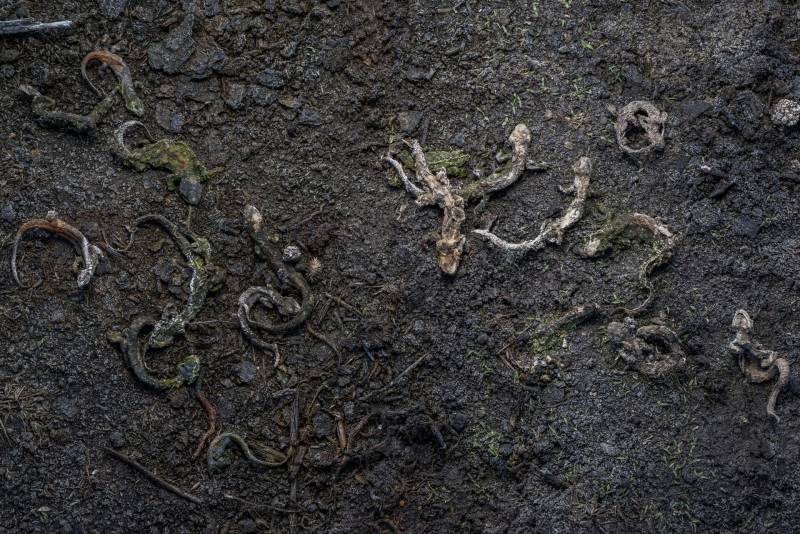
In recent years, researchers have begun to document deteriorating health in the animals, echoing a decline seen in amphibian populations worldwide. Projections suggest that things will get worse, emphasizing the need to rally around these often-overlooked animals and to help preserve their habitat. “For newts, a strategy that has worked for thousands and thousands of years is not going to work in this climate alteration that we’re experiencing,” Kats says. “And that’s just an incredible tragedy.”
After briefly considering whether he could bring buckets of water to the sickly newts, Sorokin decided the best way for him to help was to document what was happening. He kept taking pictures, hoping to draw attention to the challenges facing newts and other creatures in similar circumstances as a result of climate change. “I don’t like seeing animals in a situation where there’s no escape for them and where they’re clearly in trouble,” he says. “It’s not just in far-off exotic locations that this sort of thing is happening. It’s happening all around us. And the newts are one example.”
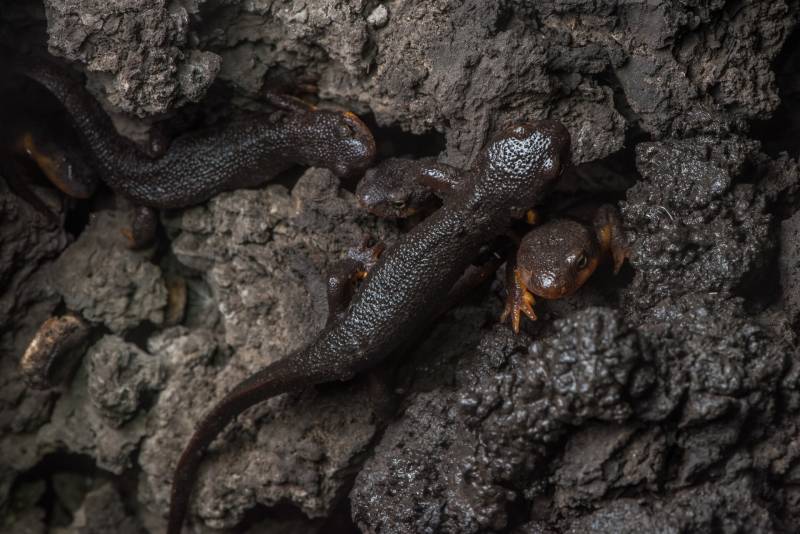
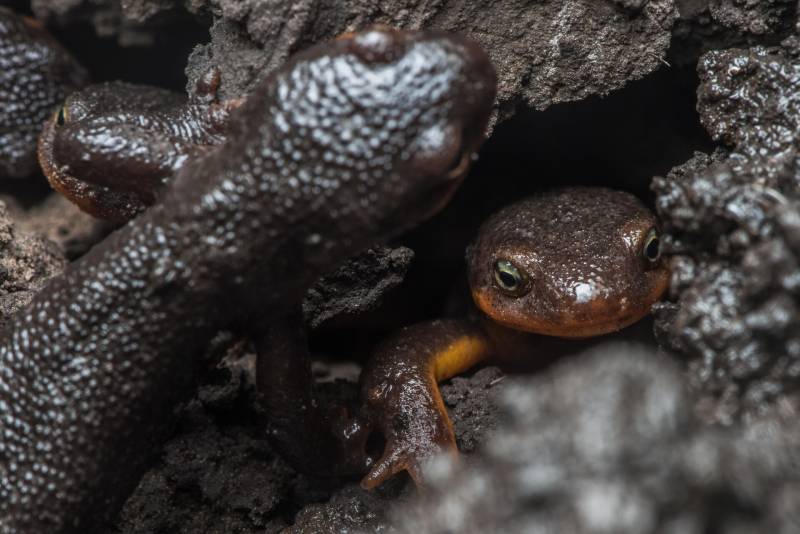
To those who know and admire it, the newt is many things: a marvel of longevity; a paragon of resiliency; a deadly vessel of poison; a model organism for regenerative medicine; a golden-eyed charmer of quiet charisma. Though newts share a flat, slithery body shape with lizards, they are amphibians (a type of salamander), not reptiles. They live an entirely different kind of life. Instead of the lizard’s flighty speed, newts move slowly and deliberately.
Unlike lizards, newts can lose a limb, heart muscle or even the lens of an eye, and grow it back — a miraculous power that has drawn the attention of scientists working to find better ways of repairing damaged organs in humans. With lives that can last for decades, newts are in no rush, Kats says. They’re chill and approachable, but armed with deadly toxins; they’re also brave, often moving almost casually around much larger creatures. They’re carnivores who live without fear. Their appeal is more subtle than the burly attraction of a polar bear or mountain lion. And that’s what makes them so endearing to those who study them. “It’s the charisma that comes with knowledge,” says Kats, who knows them as well as anyone. “I may be too passionate about this animal, but I love it.”
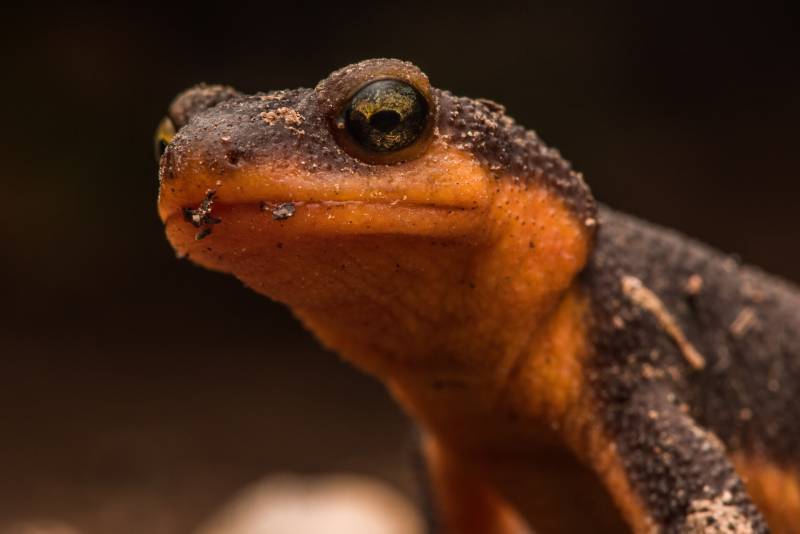
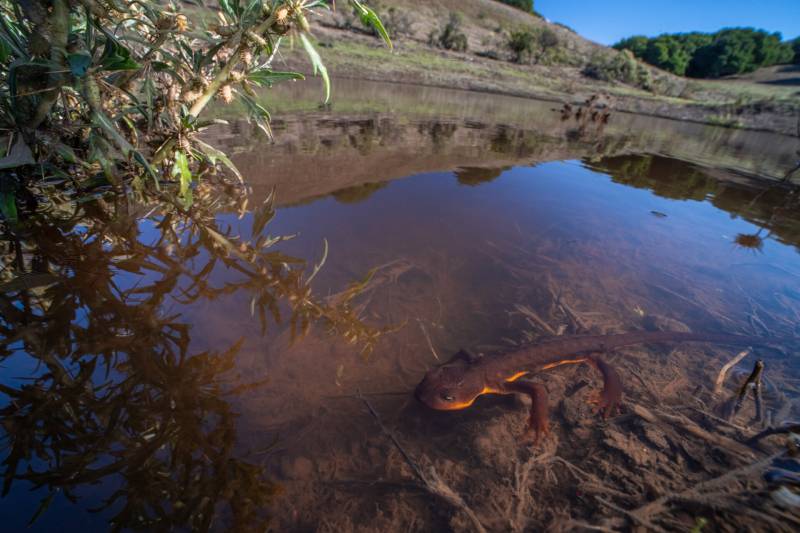
Out of 100 or so newt species around the world, four live in California. Three of them live in the Bay Area. The California newt (Taricha torosa), the kind that Sorokin observed on his hikes, has a range that extends to Southern California, where in the early 1990s, Kats started tagging them in a first-of-its-kind project. He wanted to gather basic information about the animals, so he captured a few dozen, anesthetized them and implanted rice-sized transponders — like the ones veterinarians use to identify pets—into their abdomens. Over time, the number of tagged newts has grown, allowing Kats and colleagues to recapture, identify and take measurements of individuals over time.
The results have provided key insights into the lives of newts, their extraordinary abilities, and also their vulnerabilities. Kats found that California newts reappeared around 15 meters of their last sighting, year after year, suggesting that they might not leave their habitats, even if the quality of that environment declines. The tags also revealed extremely long lives. Some of the newts with Kats’s original tags from the 1990s still appear in surveys, and they were already adults when he marked them. It’s not unusual, he says, for newts to live into their 30s and possibly even 40s — a remarkably long life expectancy compared to other amphibians. Many tree frogs live for only three to five years in the wild.
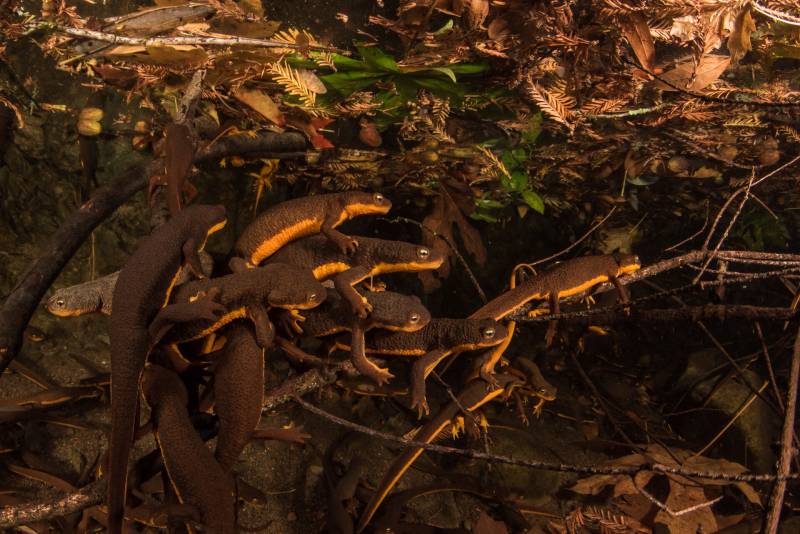
Over millennia, newts developed strategies for surviving California’s notoriously variable weather, and a long life span was part of the deal, says Samuel Sweet, a herpetologist at the University of California, Santa Barbara. The animals, which spend most of their time on land, rely on streams or ponds for mating and laying eggs. Historically, when water dried up during periodic droughts, they could defer the energy-demanding task of reproduction for a few years. And even when the conditions were unusually dry, they could often still find water. Kats remembers how, 30 years ago, streams in Southern California continued to flow even during particularly dry periods. While longer droughts were already a concern then, he thought those perennial streams would help the newts persevere.
Starting around 2013, however, streams that seemed like they would flow forever started to dry up in the springtime for what Kats thinks may be the first time in recorded history. By then, he was collaborating in the tagging work with Gary Bucciarelli, a conservation biologist at the University of California, Los Angeles, whose interests include the neurotoxins that newts harbor in their skin and how these chemicals affect other animals in the ecosystem. (Those toxins are so powerful they killed a 29-year-old man in 1979 after he swallowed an Oregon newt on a dare while under the influence of whiskey, according to a report published in the Journal of the American Medical Association.)
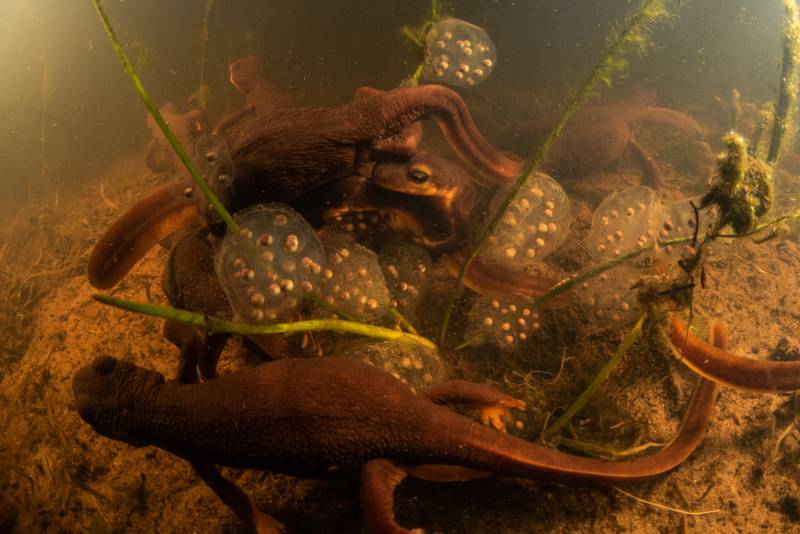
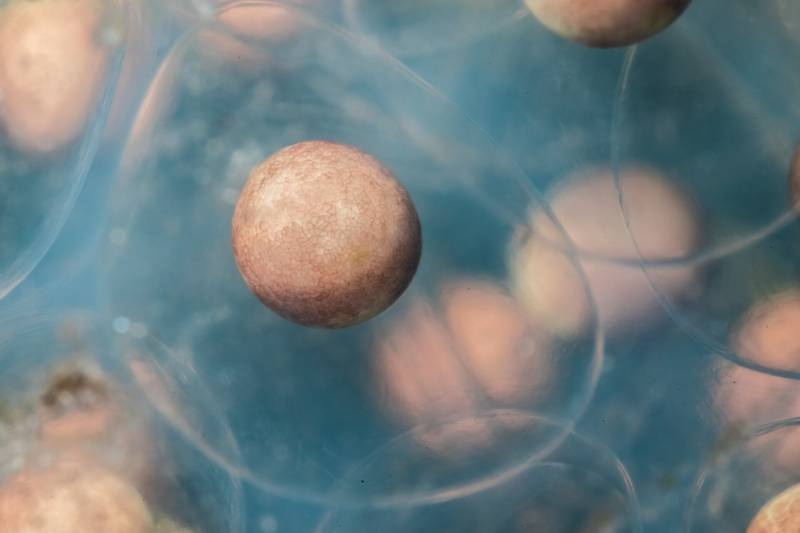
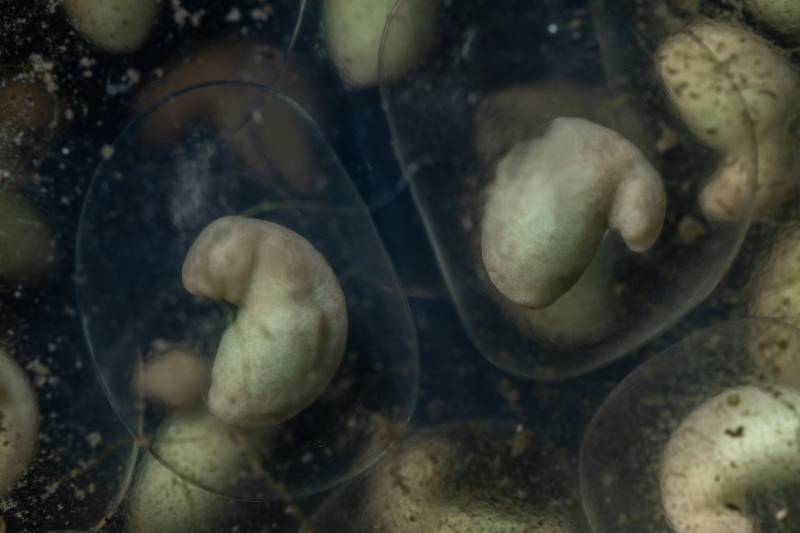
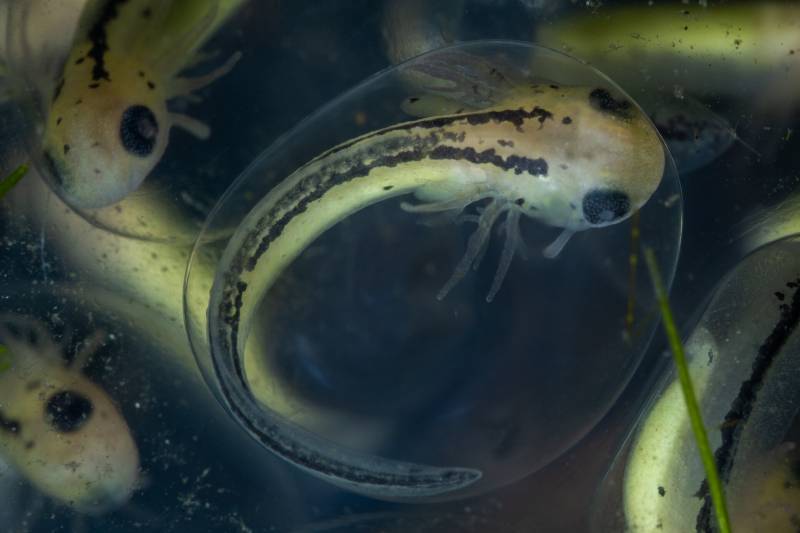
The scientists had expanded the newt research from LA’s Santa Monica Mountains south to Orange County and San Diego, east to the San Gabriel Mountains, and north to the Bay Area, Mendocino County and the Sierra Foothills. As the water dried up around LA, researchers started detecting fewer tagged newts, Bucciarelli says. By the end of 2016, many of the newts that did come back to their streams were looking scrawny and unwell. “You could see their ribs, vertebra, the pelvic girdle,” Bucciarelli says. “Things that you should not see in a healthy population.”
To figure out what was going on, the researchers looked to their large and long-term data set, where they found that what they were seeing was more than a fluke. Between 2008 and 2016, they found a nearly 20% decline in a measure of body condition among California newts across 30 breeding sites in Southern California. That period of drastic deterioration in size was more rapid than other studies have documented in any other amphibian species, Bucciarelli says. It also coincided with record-setting high temperatures and what is thought to be the most severe drought in California in 1,200 years.
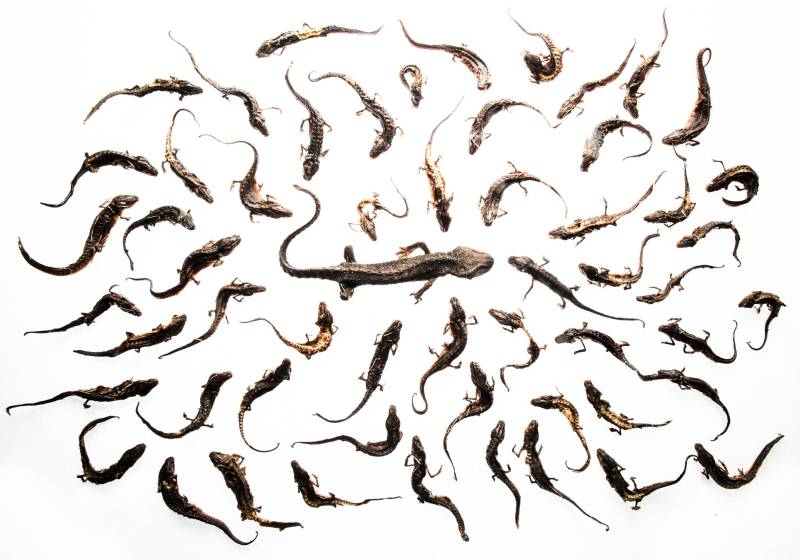
In Northern California, where climate records didn’t show the same extremes, newts appear to have retained their body condition during the same period. But with modeling, the team predicted that droughts and related declines would soon catch up to newts and other amphibians in the Bay Area and other parts of Northern California. Newts once inhabited 10 streams in the mountains above San Diego, Sweet says. Now they occupy only three of those streams. In Orange County, he estimates half the newt streams that existed in the 1960s are gone because of drought and development. “What we’re seeing in LA and San Diego counties, those are going to be the conditions sometime in the not-too-distant future in San Luis Obispo County and Monterey County,” he says.
California newts in Southern California are already classified as a species of special concern by the California Department of Fish and Wildlife, an acknowledgment of their vulnerability, although they are not yet listed as threatened or endangered. As environmental stress becomes relentless, experts worry it may be hard for them to hang on. “These newts down here have adapted to deal with drought. That’s part of our climate here in Southern California landscapes,” Bucciarelli says. “But what they haven’t evolved to deal with is drought simultaneously combined with record warming temperatures, and that’s a result of climate change. Now, a double threat is occurring.”
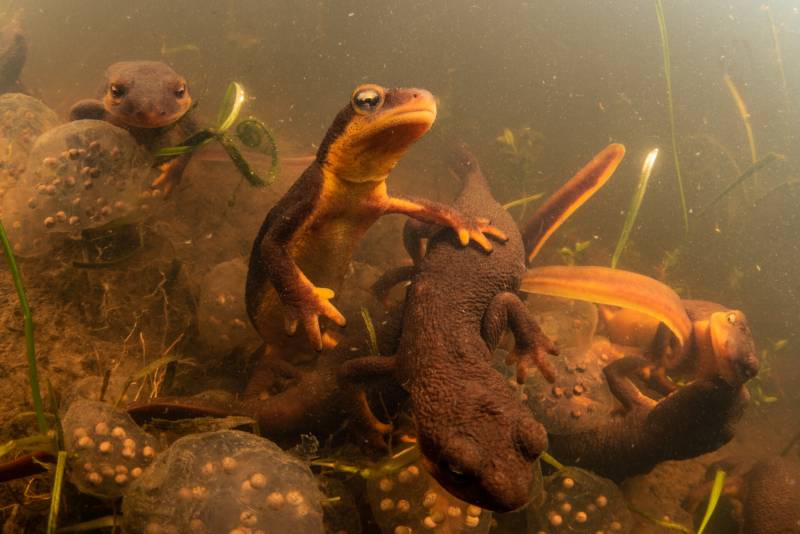
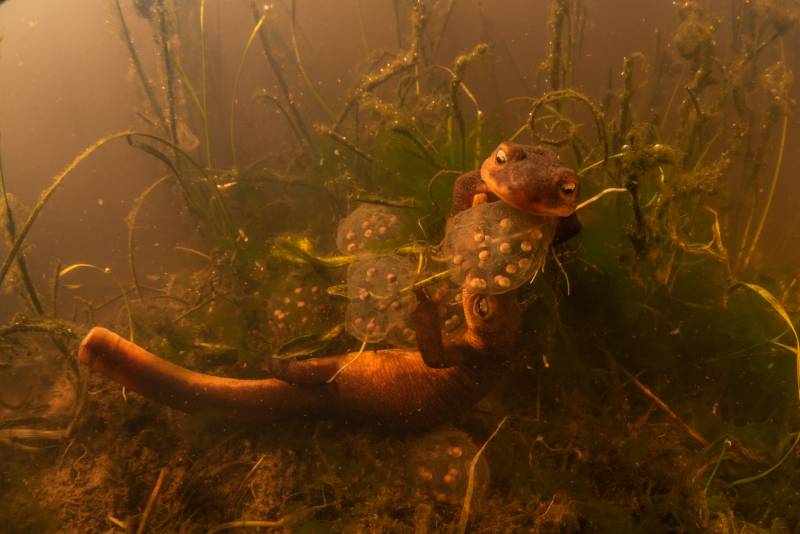
By the time Sorokin was visiting his newt pond in Berkeley in 2020, COVID-19 had upended life for humans, and California’s newts appeared to be experiencing a pandemic of their own. In addition to newts with protruding hip bones and lack of fat stored on their bodies that Kats and Bucciarelli noted, researchers started finding newts with tail lesions so severe that muscle and skin had worn away to expose the tips of their tail bones. Some animals had clouded eyeballs that looked like cataracts. The animals also acted strangely, whirling around in circles. It was the first major disease in Southern California newts in 30 years, Kats says.
Researchers at the U.S. Geological Survey euthanized an emaciated newt to investigate what had sickened it. The researchers found numerous issues, they wrote in a September 2021 report, including lungworms, inflammation in the inner ears, and parasites in its intestinal tract. Yet no single cause could explain all the symptoms. Kats suspects that extended dry spells and high temperatures may have weakened the amphibians’ immune systems, making them more vulnerable to several ordinary infections. “I’m absolutely convinced,” he says, “that the conditions they were experiencing contributed to this major disease outbreak.”
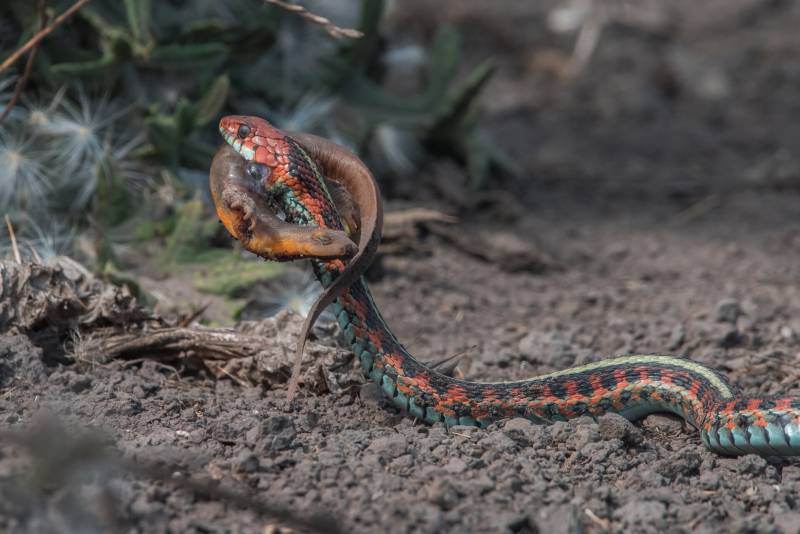
Strange illnesses and dry streambeds aren’t the only challenges facing newts. Invasive crayfish, somehow unfazed by the newts’ toxins, have been spreading in California lakes and decimating newt populations by feeding on egg masses and larvae. Blooms of cyanobacteria may be another problem: These photosynthetic microorganisms, which produce a variety of toxins of their own, have been proliferating in lakes around the world, a trend linked to warming temperatures, among other factors. In the first assessment of two Southern California lakes, published in 2021, a group of researchers from several universities and government agencies found the highest concentrations ever recorded in the region of three cyanotoxins, which have been linked to health issues in people and wildlife, including amphibians. Sorokin suspects that a cyanobacteria bloom explains the greening of that pond near his Berkeley home.
Traffic is another concern. Generally unconcerned with predators because of their poisonous skin, newts move slowly, as if they don’t have a care in the world, Kats says. After spending much of their lives in the woods and waiting on average five years, sometimes longer, to become sexually mature, they often must cross busy roads to get to streams for mating. Drivers don’t usually see them — or else they don’t stop. One of Sweet’s graduate students visited a study site in San Luis Obispo one day after it rained and counted more than 100 road-killed newts. “The average newt there might be 25 or 30 years old,” Sweet says. “They get all ready to breed: ‘I’m going to walk down to the creek and lay my eggs for the first time tonight.’ Squish. They get run over 10 minutes before they do that.”
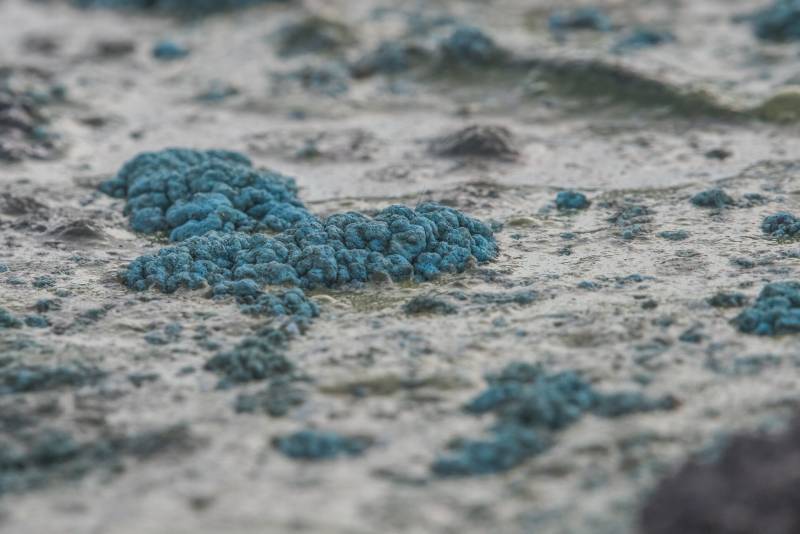
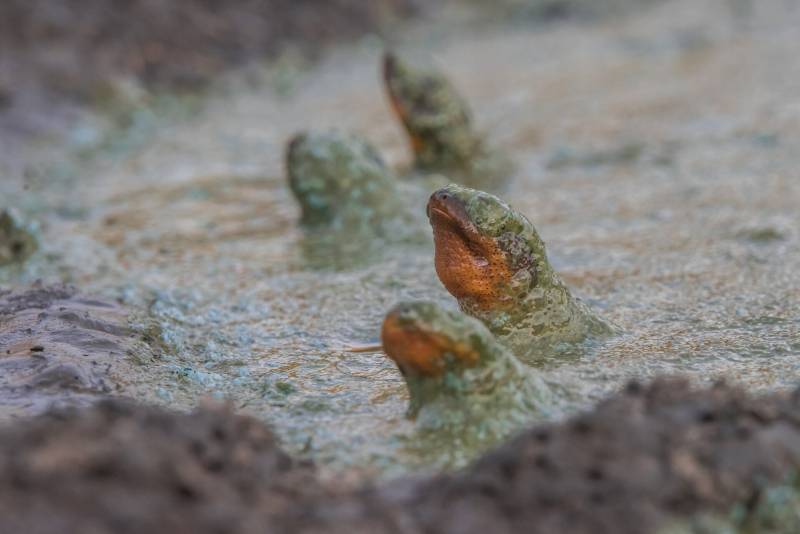
Habitat fragmentation makes it harder now than in the past for newts to cope with harsh conditions, Sweet adds. When newts experienced changes to the climate in the past, they were able to rebound and expand their range again when conditions improved. But they can’t come back if there isn’t a connected population to replenish them.
Altogether, the cards can seem stacked against a species that has endured its share of environmental stress for thousands of years. “The stuff that amphibians like newts are facing is kind of death of a thousand cuts,” Sweet says. “It’s not any one thing. It’s not drought, it’s drought and getting run over when you’re 25 years old and half an hour away from laying eggs for the first time. It’s having your eggs die because a septic tank has overflowed and the stream is full of salt. It’s getting eaten by a raccoon that’s wandering up and down the creek because somebody has garbage out and there are too many raccoons, and the road department wanted to widen the road and fill in the stream with boulders. It’s all this stuff.”
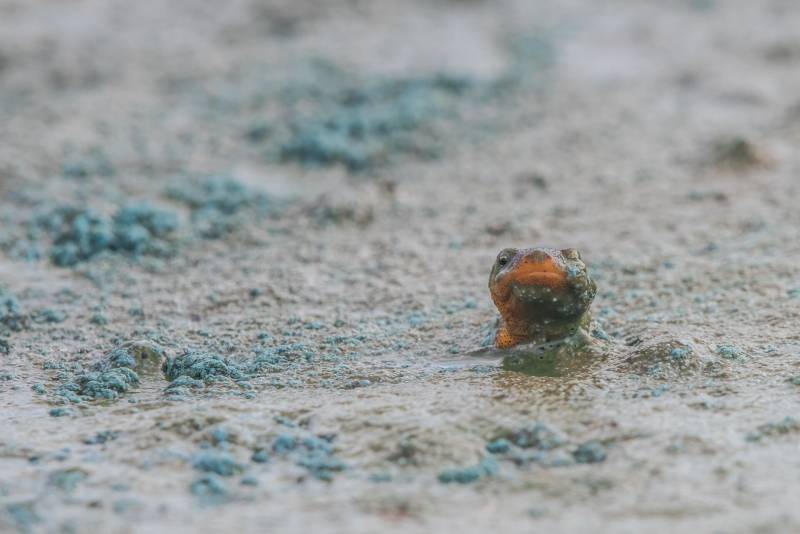
Despite all they’re up against, it’s not too late for newts, Kats says. Some environmental groups have mobilized to help newts around the world, including in California. In the hills north of San Francisco, volunteers with the Chileno Valley Newt Brigade spend winter nights picking up the amphibians as they make their way to or from their breeding sites, carrying them across roads to protect them from cars. Along the East Coast and in parts of Berkeley, roads frequented by newts are closed annually for the same reason.
Some of the most promising strategies for protecting newts focus on improving and protecting their habitats and ecosystems and, with them, biodiversity more generally, Bucciarelli says. One major effort in the works is California’s 30×30 initiative, an executive order signed by the governor that has a goal of conserving 30% of the state’s land and coastal waters by 2030. Because amphibian habitats span much of the state’s land and watersheds, they stand to benefit substantially from the plan.
Habitat protection includes human intervention to mitigate disaster and destruction. Multiple studies in Europe have shown that enlarging and deepening ponds can lead to rapid and major increases in populations of newts, frogs and toads — a technique that could be useful for removing silt after wildfires, as well. Researchers have also found value in “newt hotels,” human-made piles of stones covered with soil and fabric that mimic the kinds of environments the animals use to overwinter in harsh conditions. And in California, government agencies are actively working to create freshwater ponds that are free of invasive species, such as crayfish, to replace what amphibians have lost.
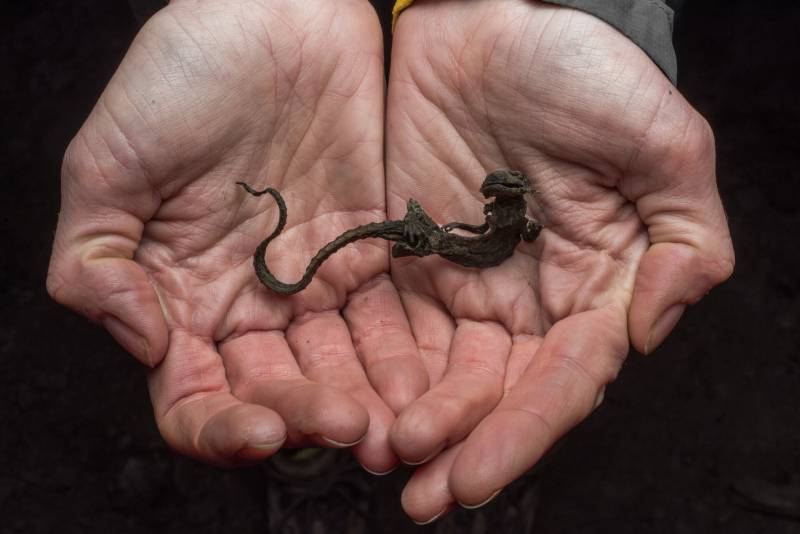
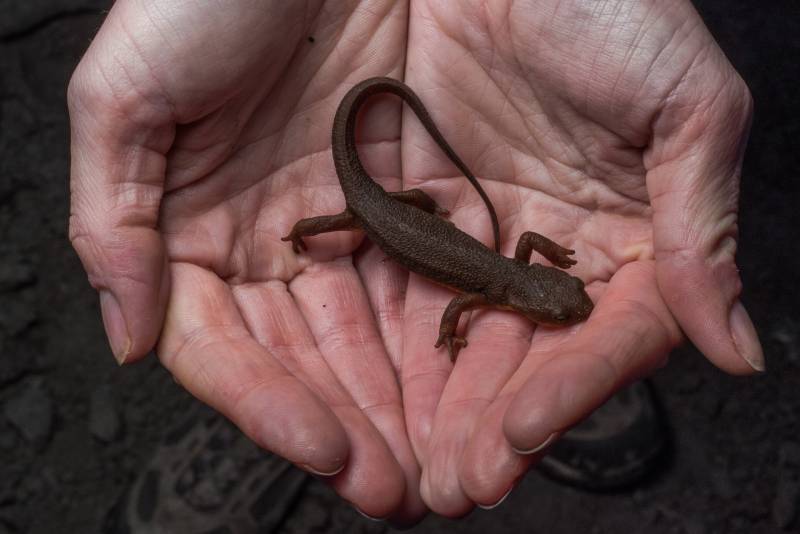
The California Conservation Genomics Project is another statewide effort to protect amphibians and other creatures, not by protecting habitat but by protecting genetic diversity. The government-funded project aims to sequence the genomes of more than 230 animal and plant species, including some amphibians and reptiles — as a way to identify areas of high and low genetic diversity that should be the focus of conservation work. The newt is not on the sequencing list in part because its genome is gigantic and intractable, Bucciarelli says. But the initiative, which has a goal of producing “the most comprehensive, multispecies, genomic data set ever assembled to help manage regional biodiversity,” focuses on creatures that share newt habitat. Those animals — and newts — would ultimately benefit from any resulting changes and protections.
Disease surveillance should help, too, by detecting emerging illnesses before they can spread. In the United States, the USGS has set up a nationwide program to check newts and other amphibians around the country for signs of a fungal infection that has devastated European salamander populations.
Efforts like these may give newts a fighting chance to do what they do best: persevere. Because newts are so long-lived, seemingly small measures could help them wait out poor conditions until favorable years return, and with those years the right conditions for mating, experts say.
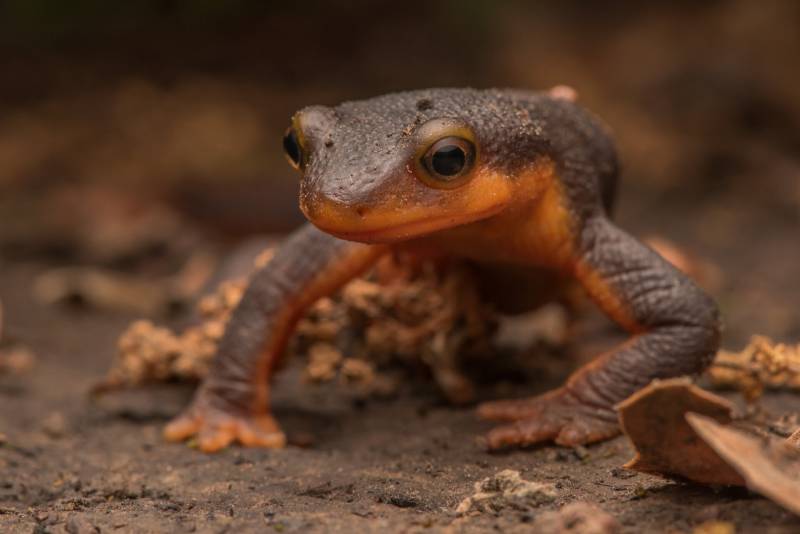
Sorokin has seen this potential for redemption in his Berkeley-area pond over the past two years. When Northern California finally got a real rainy season in late 2021, the pond refilled again. Since then, he has observed plenty of healthy newts and lots of breeding activity. When they come up for air, they sometimes let out a little squeak. Seeing them return has filled him with relief — and also trepidation. He worries about the next dry season and the next generations of newts. He takes photos, he says, to spread his love for newts to a wider audience, and to convince people to care about this animal that doesn’t get its fair share of headlines about the impacts of a changing climate.
As we move deeper into the Anthropocene, more humans need to embrace our role in protecting such animals, and we need to start now, says Bucciarelli. We put them in this predicament. It’s up to us to get them out of it. Solving the puzzle of how to help newts could have benefits far beyond one amphibian, he says — creating a road map for how we deal with many other biodiversity issues on a hotter, drier planet.
“There are so many dedicated, talented and passionate people working collaboratively to come up with viable solutions. We can’t fix the problems of drought. We can’t make it rain. But we can figure out ways to manage populations so that they have the highest probability of persisting through this really stressful time,” Bucciarelli says. “I have a lot of hope.”
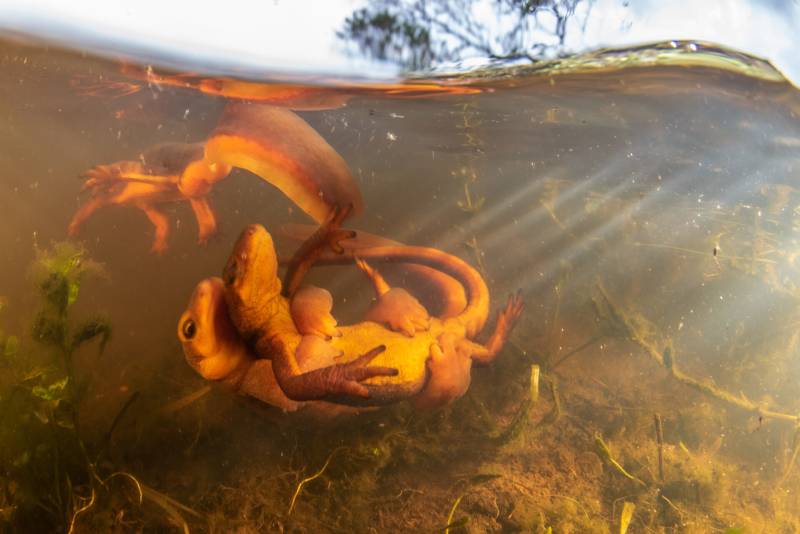
This story originally appeared in bioGraphic, an independent magazine about nature and regeneration powered by the California Academy of Sciences.
